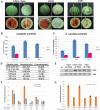Virus-induced gene silencing for in planta validation of gene function in cucurbits
- PMID: 35944218
- PMCID: PMC9706489
- DOI: 10.1093/plphys/kiac363
Virus-induced gene silencing for in planta validation of gene function in cucurbits
Abstract
Virus-induced gene silencing (VIGS) is a powerful tool for high-throughput analysis of gene function. Here, we developed the VIGS vector pCF93, from which expression of the cucumber fruit mottle mosaic virus genome is driven by the cauliflower mosaic virus 35S promoter to produce viral transcripts in inoculated plants. To test the utility of the pCF93 vector, we identified candidate genes related to male sterility (MS) in watermelon (Citrullus lanatus), which is recalcitrant to genetic transformation. Specifically, we exploited previously reported reference-based and de novo transcriptome data to define 38 differentially expressed genes between a male-sterile line and its fertile near-isogenic line in the watermelon cultivar DAH. We amplified 200- to 300-bp fragments of these genes, cloned them into pCF93, and inoculated DAH with the resulting VIGS clones. The small watermelon cultivar DAH enabled high-throughput screening using a small cultivation area. We simultaneously characterized the phenotypes associated with each of the 38 candidate genes in plants grown in a greenhouse. Silencing of 8 of the 38 candidate genes produced male-sterile flowers with abnormal stamens and no pollen. We confirmed the extent of gene silencing in inoculated flowers using reverse transcription-qPCR. Histological analysis of stamens from male-fertile and male-sterile floral buds and mature flowers revealed developmental defects and shrunken pollen sacs. Based on these findings, we propose that the pCF93 vector and our VIGS system will facilitate high-throughput analysis for the study of gene function in watermelons.
© American Society of Plant Biologists 2022. All rights reserved. For permissions, please email: journals.permissions@oup.com.
Figures






Similar articles
-
Transcriptome profiling of differentially expressed genes in floral buds and flowers of male sterile and fertile lines in watermelon.BMC Genomics. 2015 Nov 9;16:914. doi: 10.1186/s12864-015-2186-9. BMC Genomics. 2015. PMID: 26552448 Free PMC article.
-
Transcriptome analysis of watermelon (Citrullus lanatus) fruits in response to Cucumber green mottle mosaic virus (CGMMV) infection.Sci Rep. 2017 Dec 1;7(1):16747. doi: 10.1038/s41598-017-17140-4. Sci Rep. 2017. PMID: 29196660 Free PMC article.
-
Transcriptome Analysis of Watermelon Leaves Reveals Candidate Genes Responsive to Cucumber green mottle mosaic virus Infection.Int J Mol Sci. 2019 Jan 31;20(3):610. doi: 10.3390/ijms20030610. Int J Mol Sci. 2019. PMID: 30708960 Free PMC article.
-
Establishment of efficient Trichosanthes mottle mosaic virus-derived gene silencing in cucurbit plants.Stress Biol. 2025 May 20;5(1):35. doi: 10.1007/s44154-025-00238-5. Stress Biol. 2025. PMID: 40392402 Free PMC article.
-
A cucumber green mottle mosaic virus vector for virus-induced gene silencing in cucurbit plants.Plant Methods. 2020 Feb 3;16:9. doi: 10.1186/s13007-020-0560-3. eCollection 2020. Plant Methods. 2020. PMID: 32025236 Free PMC article.
Cited by
-
Establishment and optimization of a tobacco rattle virus -based virus-induced gene Silencing in Atriplex canescens.Plant Methods. 2025 Aug 7;21(1):107. doi: 10.1186/s13007-025-01427-z. Plant Methods. 2025. PMID: 40770802 Free PMC article.
-
Watermelon goes viral: introducing a vector for virus-induced gene silencing in cucurbits.Plant Physiol. 2022 Nov 28;190(4):2072-2073. doi: 10.1093/plphys/kiac438. Plant Physiol. 2022. PMID: 36124986 Free PMC article. No abstract available.
-
Establishment of virus-induced gene silencing (VIGS) system in Luffa acutangula using Phytoene desaturase (PDS) and tendril synthesis related gene (TEN).Plant Methods. 2023 Aug 31;19(1):94. doi: 10.1186/s13007-023-01064-4. Plant Methods. 2023. PMID: 37653449 Free PMC article.
-
Virus-Induced Gene Silencing (VIGS): A Powerful Tool for Crop Improvement and Its Advancement towards Epigenetics.Int J Mol Sci. 2023 Mar 15;24(6):5608. doi: 10.3390/ijms24065608. Int J Mol Sci. 2023. PMID: 36982682 Free PMC article. Review.
-
Cyclic Lipopeptides of Bacillus amyloliquefaciens DHA6 Are the Determinants to Suppress Watermelon Fusarium Wilt by Direct Antifungal Activity and Host Defense Modulation.J Fungi (Basel). 2023 Jun 19;9(6):687. doi: 10.3390/jof9060687. J Fungi (Basel). 2023. PMID: 37367623 Free PMC article.
References
-
- Antignus Y, Wang Y, Pearlsman M, Lachman O, Lavi N, Gal-On A (2001) Biological and molecular characterization of a new cucurbit-infecting tobamovirus. Phytopathology 91: 565–571 - PubMed
-
- Bang H, King SR, Liu W (2005) A new male sterile mutant identified in watermelon with multiple unique morphological features. Cucurbit Genet Coop Rep 28: 46–48
-
- Bekele D, Tesfaye K, Fikre A (2019) Applications of virus induced gene silencing (VIGS) in plant functional genomics studies. J Plant Biochem Physiol 7: 1–7
-
- Benavente LM, Ding XS, Redinbaugh MG, Nelson R, Balint-Kurti P (2012) Virus-induced gene silencing in diverse maize lines using the Brome mosaic virus-based silencing vector. Maydica 57: 206–214
-
- Bu R, Wang R, Wei Q, Hu H, Sun H, Song P, Yu Y, Liu Q, Zheng Z, Li T (2019) Silencing of glycerol-3-phosphate acyltransferase 6 (GPAT6) gene using a newly established virus induced gene silencing (VIGS) system in cucumber alleviates autotoxicity mimicked by cinnamic acid (CA). Plant Soil 438: 329–346
Publication types
MeSH terms
LinkOut - more resources
Full Text Sources

